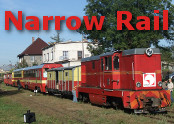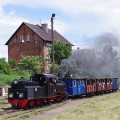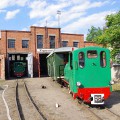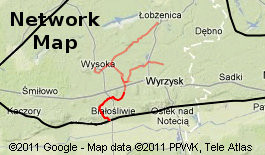Białośliwie Narrow Gauge Railway
Białośliwie Key Facts
- Gauge: 600mm
- Operating Length: 34km
- Total Length: 43km
- Status: Operating
- Location:

2015 Timetables - (Archive)
On 1 May and every Sunday from 3 May to 21 June, trains will run from Białośliwie to Pobórka Wielka at 13:00, 15:00 and 17:00.
The fifth Zlot Miłośników Kolejek 600mm (600mm Gauge Railway Enthusiasts Rally) was held from 25 to 27 June 2015. The festival visited a different location on each day. On Thursday 25 June the special trains reached Łobżenica for the first time since 2001. On Friday 26 June the trains ran from Łobżenica to Wysoka, and on Saturday 27 June they returned to Białośliwie for the traditional locomotive parade. See also the event poster.
Photo Galleries
History and Information
The railways that later became PKP's Bydgosko-Wyrzyskie Koleje Dojazdowe (Bydgoszcz-Wyrzysk Local Railways) started in 1895 as two separate 600mm gauge systems in what was then the Prussian partition of Poland. The Wirsitzer Kreisbahn (Wyrzysk Local Railway) was centred on Białośliwie and Nakło nad Notecią, while the Bromberger Kreisbahn (Bydgoszcz Local Railway) was centred on Maksymilianowo and Bydgoszcz. The surviving operational part of the network from Białośliwie to Nieżychowo and on to Łobżenica was the first part to be opened, in February 1895. Both systems grew rapidly and were linked together at an early date via Suchary, north-east of Nakło.
The two railways were formally joined as one system in 1949 and became known as the Bydgosko-Wyrzyskie Koleje Dojazdowe (Bydgoszcz-Wyrzysk Local Railways). At its greatest extent this system was 256 km long and had 8 locomotive sheds and 6 standard gauge interchange points (Białośliwie, Nakło nad Notecią, Witosław, Bydgoszcz, Maksymilianowo and Koronowo). In 1955 the system carried 1,474,000 passengers and 256,000 tonnes of freight. This map shows the full extent of the railway (click to see the map at full size on the BWKD website):
The first branch closures started in the 1950s, and lines were progressively closed in the 1960s, 70s and 80s. By 1989 162km of lines were still in use but in steep decline, and the system was closed completely on 1 January 1994. Some of the stock moved to the Żnin narrow gauge railway, some to the newly created Myślęcinek park railway in Bydgoszcz in 1996, and some was scrapped, but a large amount remained at Białośliwie including 6 Lyd2 locomotives and numerous freight wagons.
In the years immediately before closure a few special trains were run for tourists, most notably the special trains organised by InterLok Piła in 1992, using three steam locos, which traversed the entire system from Białośliwie to Koronowo. This tour included the first crossing for many years of the spectacular viaduct over the Brda river to Koronowo (which still exists today as a foot/cycle bridge), and steam-hauled freight trains ran into Gądki brandy distillery and Nakło sugar factory. See Hermann Schmidtendorf's report (in German) on the InterLok website. In September and October 2000, and again in April 2001, the Poznań model railway club organised a series of trips from Białośliwie to Łobżenica using the Borsig 0-4-0 steam loco which is normally based on the Maltanka park railway in Poznań. At around the same time, Piła county took over the line within their borders from PKP, and appointed Towarzystwo Wyrzyska Kolejka Powiatowa (the Wyrzysk District Railway Society) to operate the line.
Today only one of the 8 operational bases and sheds remains in use, at Białośliwie. From Białośliwie the surviving line runs north through forest and alongside a small stream to the first loop and intermediate halt at Kocik Młyn, then turns east and continues to climb up through orchards to the next intermediate station of Pobórka Wielka. The line reaches open farmland on the plateau north of the Notec river valley, then turns northward once more to reach the sizeable village of Nieżychowo. Beyond Nieżychowo the line crosses the main A10 road on the level. Immediately north of the road in the village of Zakłady Przemysłowe where there was once a sugar works, there is a triangular junction. The main line continues north while a disused branch heads east to Polinowo. The next junction on the main line is at Czajcze, where a short branch heads south west to Wysoka, and the main line continues north east to the town of Łobżenica. The route was restored through to Łobżenica in time for the 120th anniversary celebrations on 25 June 2015.
Białośliwie is easily reached by train. There are 6 to 8 REGIO trains a day on the Bydgoszcz to Piła line and all stop at Białośliwie. Public narrow gauge trains run on summer weekends only. The best time to visit the line is during the annual Zlot Miłośników Kolejek 600mm (gathering of 600mm gauge railway enthusiasts), the first of which was held in June 2011. The second was held from 7 to 10 June 2012 and the third from 30 May to 2 June 2013. The fourth Zlot Miłośników Kolejek 600mm was split over two events, 19-22 June and 25-28 September 2014. The fifth was held from 25-27 June 2015.
Links
- Towarzystwo Wyrzyska Kolejka Powiatowa (TWKP) - New website
- Bydgosko Wyrzyskie Koleje Dojazdowe - Older website with historical information
- Wyrzyska Kolejka Powiatowa - Discussion Forum
- The Białośliwie railway on Railmap by Jarosław Woźny
- Aerial photos of Białośliwie
- Koleje wąskotorowe w Polsce (www.koleje.wask.pl) by Krzysztof Zientara
- Polish Narrow Gauge Railways (www.cleeve.com) by Andrew Goodwin, Stephen Goodwin and Dave Meller
- Behind the Water Tower blog - Białośliwie Posts:
- Alarm bells at Bialosliwie, 6 January 2010
YouTube Videos and Slideshows of Białośliwie:
Coal trains in 1991
Sugar beet trains in 1991
Moving Lyd2s out of collapsing shed
Tourist and works trains











































